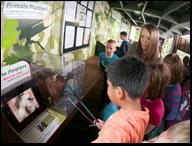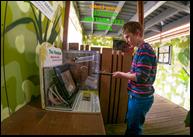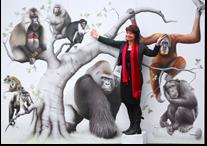‘Living Links to Human Evolution’ Research Centre: research-led public engagement with science
Submitting Institution
University of St AndrewsUnit of Assessment
Psychology, Psychiatry and NeuroscienceSummary Impact Type
SocietalResearch Subject Area(s)
Medical and Health Sciences: Neurosciences, Public Health and Health Services
Summary of the impact
World-leading primate research by the `Origins of Mind' group led to the
creation of the University's £1.6M `Living Links to Human Evolution'
Research Centre, intentionally located in Edinburgh Zoo where it has pioneered
unique public engagement and science education using a range of
materials and activities. The research has thus impacted on: i)
society and culture: since 2008, around 250,000 visitors per year
have engaged with live, on-going science and multiple associated legacy
resources and activities; ii) educational practitioners and school
children, through classes in the Centre and internet teacher packs
that integrate with Scottish Highers; and iii) commercial income
to the Zoo.

Underpinning research
The School is recognised for world-leading research on primate behaviour
and cognition. The reputation of the `Origins of Mind' research group has
continuously risen since the appointments of Andrew Whiten (1975 to
present) and Richard Byrne (1976 to present), and later others, notably
Klaus Zuberbühler (2001 to present). All three professors have been
elected Fellows of the Royal Society of Edinburgh (Whiten, 2001; Byrne,
2002; Zuberbühler, 2011), and Whiten is a Fellow of the British Academy
(2000). During the REF period, their research has been supported by over
£3.5M of grant funding, e.g., from ERC, John Templeton Foundation and
National Geographic.
The research has focused on big scientific questions about the origins of
major aspects of psychology, including culture, social learning, vocal and
gestural communication. For example, in collaboration with 8 leaders of
Africa's long-term study sites, Whiten published `Cultures in
chimpanzees', collating decades of field research to reveal 39 different
behavioural traditions an unique local `cultures' (Whiten et al.,
Nature 1999). Whiten also pioneered novel cultural diffusion
experiments demonstrating a range of social learning processes in human
and non-human primates (e.g. Whiten et al., J Comp Psychol
1996), as well as the capacity of chimpanzees to sustain multiple
traditions in different groups (e.g. Whiten et al., Nature
2005). Byrne's research has examined the complex, hierarchical processing
of food items by wild apes, leading to the highly influential concept of
program-level imitation (Byrne and Russon, Behav Brain Sci, 1998).
Zuberbühler's research has discovered features of language present in
primate vocal communication, using sophisticated field vocal playback
experiments to examine referential aspects of primate calls. This research
has shown that primates communicate about different food values (Slocombe
and Zuberbühler, Curr Biol, 2005) and that different meanings
arise from different combinations of calls (Arnold and Zuberbühler, Nature,
2006).
Building directly on the international reputation thus earned, in 2004
Whiten and Zuberbühler led a successful £1.6M bid for a Strategic Research
Development Grant (SRDG) from the Scottish Funding Council to establish a
University research centre in Edinburgh Zoo, a collaboration with its
parent organisation, the Royal Zoological Society of Scotland (RZSS). This
funding was used to create an innovative research facility unique within
the UK and comparable to leading primate behaviour research centres around
the world (e.g., Max Planck Köhler Centre in Leipzig). The resulting
`Living Links to Human Evolution' Research Centre, opened in the Zoo in
2008, is owned by the University of St Andrews and contains mixed-species
communities of ~70 monkeys. Large inner and outer enclosures are coupled
with bespoke testing areas that monkeys enter voluntarily and interact
with experimental arrays, which has provided excellent facilities for
testing the cognitive capacities of these monkeys. All research areas are
in full view of the public galleries, fulfilling the key aim of Living
Links to combine world-leading research with an unprecedented scale of
public engagement. It does so through activities directly based on the
research outlined above and this important impact link is explicated in
section 4. Visiting children also take part in on-going child development
studies paralleling those conducted on the non-human primates.
Whiten has been Director of Living Links since 2008. A recently appointed
lecturer, Dr Amanda Seed (2010), is Deputy Director. St Andrews staff and
students are the main users of Living Links, while research time is also
bookable by other members of the Scottish Primate Research Group from
Stirling, Edinburgh, Heriot-Watt and Abertay Universities. Additionally,
since 2005, RZSS have been core sponsors of the Budongo Conservation Field
Station in Uganda, of which Zuberbühler is the Scientific Director (2005
to present). Over 12 PhD and masters' level students from St Andrews have
studied chimpanzees and other primates at the field site since. Based on
the model of Living Links, RZSS also built the £5.6M Budongo Trail
chimpanzee enclosure and visitors centre, opened later in 2008. This
facility is used by St Andrews researchers to conduct studies on
chimpanzees (e.g., vocalisation play-backs), and includes a 170-seat
lecture theatre used in Living Links' public engagement programme.
References to the research
These illustrative references are drawn from a total of >300 articles
indexed for Byrne, Whiten and Zuberbühler since 1993. Italics = St
Andrews researcher; IF = impact factor; citations = Scopus.
Arnold, K. and Zuberbühler, K. (2006). Language evolution:
Semantic combinations in primate calls. Nature, 441,
303. IF ~ 36, 74 citations, doi: 10.1038/441303a.
Slocombe, K. E. and Zuberbühler, K. (2005) Functionally
referential communication in chimpanzee. Current Biology,
15, 1779-84. IF = 10, 48 citations, doi: 10.1016/j.cub.2005.08.068
Whiten, A., Custance, D. M., Gomez, J., Teixidor,
P. and Bard, K. A. (1996). Imitative learning of artificial fruit
processing in children (Homo sapiens) and chimpanzees (Pan
troglodytes). Journal of Comparative Psychology,
110, 3-14. IF ~ 2, 172 citations, doi: http://www.ncbi.nlm.nih.gov/pubmed/8851548
Whiten, A., Goodall, J., McGrew, W. C., Nishida, T., Reynolds, V.,
Sugiyama, Y., Tutin, C. E. G., Wrangham, R. W. and Boesch, C. (1999).
Cultures in chimpanzees. Nature, 399,
682-685. IF ~ 36, 664 citations, doi: 10.1038/21415
(identified by a Lab Times survey of animal behaviour papers as
the most cited of 19,000+ surveyed across all of Europe from 1999
to 2010).
Whiten, A., Horner, V. and de Waal, F. B. M. (2005).
Conformity to cultural norms of tool use in chimpanzees. Nature,
437, 737-740. IF = 26, 191 citations, doi: 10.1038/nature04047
Details of the impact
The research summarised in Section 2 has had substantial impact on: i) society
and culture, through public engagement with live science in
action, where beneficiaries have included ~250,000 public visitors
each year since the opening of Living Links in 2008; ii) practitioners
in secondary school science education, where the users and
beneficiaries have been teachers and school children; and iii)
commercial income through enhanced Zoo ticket sales.
i) Impact on society and culture Multiple strands of
engagement based on the research have been built up since 2008: these
include the public being encouraged to view all research done in
Living Links live, over the shoulders of the scientists, through
this and other activities thus learning about both our scientific
discoveries including those outlined in Section 2, and the scientific
methods used to obtain them; involvement of parents and teachers in
comparative child research; a central Science Exploration Zone
including numerous hands-on electronic and physical activities; public
talks and discussions in the Budongo Trail lecture theatre (e.g.,
`Living Links to Human Health, Mind and Medicine', 2011; `Twenty-first
Century research associated with twenty-first Century zoos', 2012;
supporting evidence S6); and displays and murals. For
example, one interactive challenge that visitors are invited to engage
with includes the `panpipes' foraging tasks that require tool use for
their solution and replicate those used in the original chimpanzee
research (Whiten et al., Nature 2005, listed in Section 3).
Each task is accompanied by video showing chimps using their local
cultural technique; visitors are invited to solve the task themselves to
gain an artificial grape (see photo). They are then directed to a second
panpipes device where they see the alternative cultural approach, and
through this are led to understand more about both our scientific
methods and our scientific discoveries themselves. Examples of other
activities directly based on research outlined in Sections 2/3 include
hands-on displays and video clips illustrating Zuberbühlers' research on
primates' referential vocalisations. Together, over 20 such elements
constitute a substantial legacy resource of cultural artefacts
supporting public and high-school engagement with science.

Evidence of significance and breadth of impact:
a) Scale of visits Samples of direct counts of
Living Links visitors together with calibrated broken-beam automatic entry
counters, in conjunction with known Zoo entry gate numbers, allowed
calculation that approximately 40% of visitors to the Zoo visit Living
Links, thus amounting to approximately ~250,000 per year, or over
1.5 million since 2008 (S1).
b) Sustained funding Funding agencies have
expressed confidence in our impact by awarding a series of public
engagement grants, supporting a full-time Public Engagement Officer
(2009-2013). A Scottish Government engagement grant (S7) was
followed by two from the Wellcome Trust (S8), the
second necessarily awarded only on the basis of the Trust's judgment
that our public engagement work has had the impacts it was designed to
have. One of the public engagement exhibits (`My Primate Family
Tree': see photo) was inaugurated by Prof. Anne Glover, Chief Scientific
Adviser to the Scottish Government at the time and now Chief Scientific
Adviser to the EU Presidency, indexing continued governmental support for
Living Links.

c) Direct evaluation of engagement The Public
Engagement Officer's quantitative data (S2) demonstrated that visitors
engaged with the materials in Living Links longer as more activities
have been incorporated during the REF period, and were engaged
the longest when active viewable research work was underway.
Unusually for these kinds of data, the quality of the exercise was such
that results were published in a well-respected, peer-reviewed journal
(Bowler MT, Buchanan-Smith HM and Whiten A. (2012). Assessing public
engagement with science in a university primate research centre in a
national zoo. PLoS One 7, e34505). For periods when the active research is
not underway, video streams of research demonstrations are projected in
the research rooms.
ii) Impact on practitioners in secondary school science education
Under the sponsorship of a Wellcome Trust public engagement grant (S8)
the Public Engagement Officer has created a series of teacher packs
and made them available in 2012-2013 to secondary school teachers of
Scottish Highers in Biology (Highers recently came to include
primatology and animal behaviour) via the Living Links website, Living
Links YouTube channel, and Times Higher Education Supplement websites.
Three of the four teacher packs build directly upon the research described
in Section 2; for example, the pack on `Primate communication' draws
directly on the chimpanzee vocal playback experiments described above
(Slocombe and Zuberbühler 2005, listed in Section 3), guiding students to
understand the underlying principles of the science and learn about
primate cognition. The `Measuring behaviour' and `Working
with scientific literature' packs each include video clips made at
Living Links for teachers to use in classes and a powerpoint presentation
about the topic concerned. A teacher described the packs as `highly
engaging, relevant and current', and stated that `teachers and
pupils will be greatly enthused' (S3).
Evidence of significance and breadth of impact:
a) Teacher pack downloads Providing a direct measure
of change in practice of teachers, data from the Living Links
website, the Living Links YouTube channel and the Times Higher Education
Supplement website record over 2,600 views and over 1,500
downloads of the packs to the end of July, 2013 (S4).
Downloads have reached beyond Scotland to many countries (e.g. 18%
USA). Thus, these materials are being adopted by a substantial and
diverse group of practitioners. The Living Links YouTube Channel has
139 subscribers and 109,166 views (31/07/2013), and the total views of the
primate education resources are 29,550 (combined Youtube and Vimeo to
31/7/13) (S4). Living Links also has a Twitter account for
disseminating research and advertising events.
b) Teacher and class visits Complementing this outreach, approximately
3,700 students per year take part in organised educational activities
involving Living Links (S4). In collaboration with the RZSS
Education team, the Public Engagement Officer also conducts summer
science schools, which have attracted ~50 children per year
(2008-present) (S4). In 2012, a one-day Global Classroom
conference for secondary school students, which included a
chimpanzee communication workshop, attracted 220 students from 13
secondary schools, and a similar event in 2013 attracted 240 students (S4).
Adult students have engaged with the research presented at Living Links
via the RZSS adult class (72 students in 2012) and visits from the
University of the Third Age (77 participants in 2013) (S4). Living
Links is involved in the Zoo's Continued Professional Development events
for science teachers, which attracted 23 science teachers from 15 schools
across Scotland in 2013 (S4).
iii) Impact on commercial income benefits More people
(661,763) visited the Zoo in the year that Living Links opened (2008) than
in the previous year (607,763; 2007), equalling an increased gate
intake of approximately £750,000 at present prices (S5). The
CEO stated that the RZSS `has benefitted enormously from the Public
Engagement achievements of University of St Andrews researchers',
that `Living Links is one of the most popular and educational of the
exhibits in the Zoo' and that the `exceptionally high quality of
the Public Engagement in Living Links has inspired our own Education
Department to emulate and build upon these achievements' (S5).
Sources to corroborate the impact
S1 Estimates of visitor numbers to Living Links are based on
samples of direct counts in conjunction with calibrated broken-beam
entrant counters and known Zoo entrant numbers in 2011, plus annual Zoo
entrant numbers 2008-13 held by RZSS Senior Education Department staff.
S2 Systematic, quantitative observational data on visitor dwell
times are held by RZSS Senior Education Department staff. Confirmation
letter available.
S3 Teacher packs are freely available at http://www.living-links.org/resources/materials-for-teachers/,
and the quote is from a teacher at the Hutchesons' Grammar School, Glasgow
(letter).
S4 Corroboration is through quantitative data provided by RZSS
Senior Education Officer.
S5 Corroboration of Zoo visitor numbers and quote are provided by
CEO, RZSS.
S6 Talks programmes are documented on page 22 of `Living Links
Public Engagement with Science' illustrated booklet on file and viewable
at http://www.living-links.org/visitors-2/public/.
S7 Office of the Chief Scientific Adviser to the Scottish
Government, 2009, Science Engagement Grant, Living Links to Human
Evolution, £18,000. On record, University Grants Office.
S8 (i) Wellcome Trust Public Engagement People Award 2010
(WT09444MA), `Living Links to Human Biology and Medicine', £29,995.
ii) Wellcome Trust Public Engagement People Award 2012 (WT098133), `Living
Links to Human Biology and Medicine: Extensions & Outreach'
£29,196.